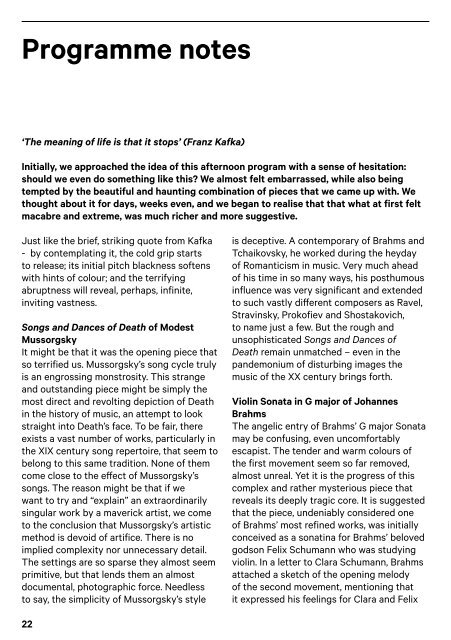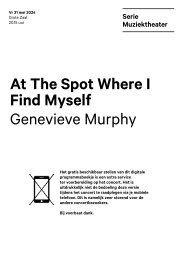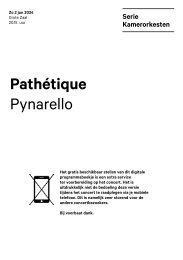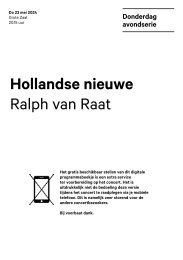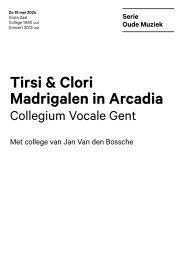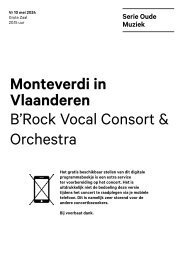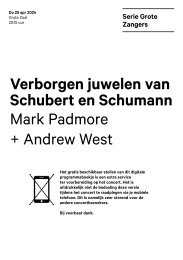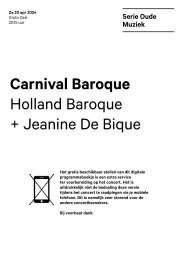You also want an ePaper? Increase the reach of your titles
YUMPU automatically turns print PDFs into web optimized ePapers that Google loves.
Programme notes<br />
‘The meaning of life is that it stops’ (Franz Kafka)<br />
Initially, we approached the idea of this afternoon program with a sense of hesitation:<br />
should we even do something like this? We almost felt embarrassed, while also being<br />
tempted by the beautiful and haunting combination of pieces that we came up with. We<br />
thought about it for days, weeks even, and we began to realise that that what at first felt<br />
macabre and extreme, was much richer and more suggestive.<br />
Just like the brief, striking quote from Kafka<br />
- by contemplating it, the cold grip starts<br />
to release; its initial pitch blackness softens<br />
with hints of colour; and the terrifying<br />
abruptness will reveal, perhaps, infinite,<br />
inviting vastness.<br />
Songs and Dances of Death of Modest<br />
Mussorgsky<br />
It might be that it was the opening piece that<br />
so terrified us. Mussorgsky’s song cycle truly<br />
is an engrossing monstrosity. This strange<br />
and outstanding piece might be simply the<br />
most direct and revolting depiction of Death<br />
in the history of music, an attempt to look<br />
straight into Death’s face. To be fair, there<br />
exists a vast number of works, particularly in<br />
the XIX century song repertoire, that seem to<br />
belong to this same tradition. None of them<br />
come close to the effect of Mussorgsky’s<br />
songs. The reason might be that if we<br />
want to try and “explain” an extraordinarily<br />
singular work by a maverick artist, we come<br />
to the conclusion that Mussorgsky’s artistic<br />
method is devoid of artifice. There is no<br />
implied complexity nor unnecessary detail.<br />
The settings are so sparse they almost seem<br />
primitive, but that lends them an almost<br />
documental, photographic force. Needless<br />
to say, the simplicity of Mussorgsky’s style<br />
is deceptive. A contemporary of Brahms and<br />
Tchaikovsky, he worked during the heyday<br />
of Romanticism in music. Very much ahead<br />
of his time in so many ways, his posthumous<br />
influence was very significant and extended<br />
to such vastly different composers as Ravel,<br />
Stravinsky, Prokofiev and Shostakovich,<br />
to name just a few. But the rough and<br />
unsophisticated Songs and Dances of<br />
Death remain unmatched – even in the<br />
pandemonium of disturbing images the<br />
music of the XX century brings forth.<br />
Violin Sonata in G major of Johannes<br />
Brahms<br />
The angelic entry of Brahms’ G major Sonata<br />
may be confusing, even uncomfortably<br />
escapist. The tender and warm colours of<br />
the first movement seem so far removed,<br />
almost unreal. Yet it is the progress of this<br />
complex and rather mysterious piece that<br />
reveals its deeply tragic core. It is suggested<br />
that the piece, undeniably considered one<br />
of Brahms’ most refined works, was initially<br />
conceived as a sonatina for Brahms’ beloved<br />
godson Felix Schumann who was studying<br />
violin. In a letter to Clara Schumann, Brahms<br />
attached a sketch of the opening melody<br />
of the second movement, mentioning that<br />
it expressed his feelings for Clara and Felix<br />
22


